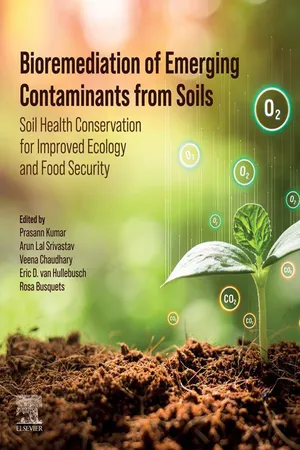
Bioremediation of Emerging Contaminants from Soils
Soil Health Conservation for Improved Ecology and Food Security
- 350 pages
- English
- ePUB (mobile friendly)
- Available on iOS & Android
Bioremediation of Emerging Contaminants from Soils
Soil Health Conservation for Improved Ecology and Food Security
About This Book
Bioremediation of Emerging Contaminants from Soils: Soil Health Conservation Along with Food Security deals with current challenges of sustainable soil health using eco-friendly approaches. This book provides ways of reducing the chemicals burden on the soil by maintaining balance in terms of society, environment and economy, which are considered basic pillars of sustainability.
Designed to highlight soil health best practices for both environmental and agricultural sustainability, these approaches are also considered important for improving global food security by ensuring safe growing conditions for crops for food and feed. Presented in two parts, the book first highlights emerging contaminants and their sources. The second part explores a variety of steps and tools for addressing contaminated soils including bio- and phytoremediation options. Case studies in each part provide real-world insights for practical application.
This book will be unique in the specified area of sustainability using the principles of bioremediation. Moreover, scientists, researchers, and policymakers will receive insights to develop and explore innovate approaches to achieve sustainable development goals.
-
Contains the latest practical and theoretical aspects of the soil health crisis and its management
-
Presents collective information to ensure the remediation of soil from emerging contaminants
-
Serves as baseline information for environmental issues in agriculture along with their alternative eco-friendly solutions
Frequently asked questions
Information
Table of contents
- Cover image
- Title page
- Table of Contents
- Copyright
- List of contributors
- About the editors
- Chapter 1. Exponential population growth and global food security: challenges and alternatives
- Chapter 2. Agricultural soil contamination due to industrial discharges: challenges for public health protection and food security
- Chapter 3. Traditional approaches of agriculture soil remediation: boon or bane for global food security
- Chapter 4. Polycyclic aromatic hydrocarbons bioremediation mechanisms by nonligninolytic fungi: a multiscale approach
- Chapter 5. Phenolic compounds: a significant threat to agricultural soils
- Chapter 6. Pharmaceutical compounds: a recent threat to agricultural soils (sources, transport, and negative impacts on the crop’s quality and other adjacent ecosystems)
- Chapter 7. Sources of inorganic nonmetallic contaminants (synthetic fertilizers, pesticides) in agricultural soil and their impacts on the adjacent ecosystems
- Chapter 8. Sources of inorganic metallic contaminants (lead, cadmium, arsenic, etc.) in agricultural soil and their impacts on the adjacent ecosystems
- Chapter 9. Environmental threats posed by xenobiotics
- Chapter 10. Bioremediation of xenobiotic contamination in soil
- Chapter 11. Transgenic plants as a source of xenobiotic remediation
- Chapter 12. Xenobiotic stress management by microbial endophytes
- Chapter 13. Case studies on emerging contamination of soil
- Chapter 14. Bioremediation of metal-contaminated soil: comparison of microbial agents with plants
- Chapter 15. Phytoremediation of metal contaminated soil using energy crops: soil health maintenance along with biofuel production
- Chapter 16. Phytoremediation of phenolic compounds from soil
- Chapter 17. Phytoremediation of pharmaceutical compounds in soil
- Chapter 18. Alternative natural options of synthesized agrochemicals
- Chapter 19. Role of enzymes in the optimization of traditional phytoremediation processes of soil
- Chapter 20. Optimized phytoremediation process for the sustainable management radionuclides
- Chapter 21. Role of indigenous knowledge in agricultural soil reclamation without disturbing other ecosystems
- Chapter 22. Role of hyperaccumulators in the reduction of emerging industrial pollutants from soil
- Chapter 23. Microbes-assisted bioaugmentation process in the reduction of emerging industrial pollutants from soil
- Chapter 24. Application of genetically modified crops against metallic contaminations
- Chapter 25. Crop rotation patterns and soil health management
- Chapter 26. Application of microphytes for soil reclamation
- Chapter 27. Utilization of genetically modified weed plants against industrial contaminants: a promising tool of phytoremediation
- Chapter 28. Case studies on management practices for emerging contamination of soil, challenges and future scope
- Index